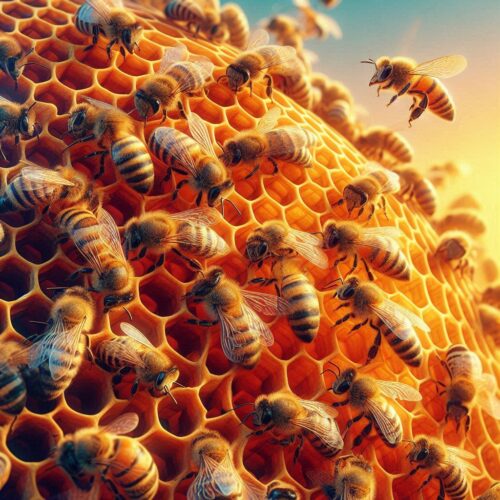Honeybees: 5 Ways Nature’s Unsung Architects Point to the Creator
In a single hive, up to 60,000 honeybees work together with a precision that would make NASA engineers envious. They build structures that achieve mathematical perfection, navigate with systems more sophisticated than GPS, and organise societies that function flawlessly without any central management. Yet these remarkable creatures accomplish all this with brains smaller than pinheads.
When we examine the honeybee closely, we discover not the products of random mutations and natural selection, but the unmistakable fingerprints of intelligent design. From their hexagonal architecture to their waggle-dance communication, honeybees reveal five compelling ways that point directly to their Creator.
1. MATHEMATICAL PERFECTION IN HEXAGONAL ARCHITECTURE
Walk into any hardware store and you’ll find construction materials in squares, rectangles, and triangles. But you won’t find hexagons—and there’s a mathematical reason why. The hexagonal cells that honeybees construct represent the optimal solution to a complex engineering problem: how to store the maximum amount of honey while using the minimum amount of precious beeswax.
This isn’t just impressive—it’s mathematically perfect. The 120-degree angles of hexagonal cells provide maximum storage space while creating the strongest possible structure with the least material. The hexagonal pattern also facilitates ideal airflow for temperature regulation and provides structural integrity that can support 25 times the bee’s own weight.
Here’s what makes this truly remarkable: human mathematicians only proved that hexagons were the optimal solution in 1999, when Thomas Hales finally demonstrated the “Honeycomb Conjecture.” Bees had been implementing this advanced mathematical principle for millennia before we even understood why it worked.
How could mindless evolutionary processes stumble upon a solution that required human genius and sophisticated mathematics to prove?
2. NAVIGATION SYSTEMS THAT SURPASS MODERN TECHNOLOGY
The Waggle: Imagine trying to give directions to a location five miles away using only a dance. Impossible? Not for honeybees. Through their famous “waggle dance,” bees communicate precise information about distance, direction, and even the quality of food sources they’ve discovered.
Navigation Skills: But their navigation capabilities go far beyond dance communication. Honeybees can detect polarised light patterns invisible to human eyes, allowing them to navigate using the sun’s position even on cloudy days. They possess internal magnetic compasses for orientation, create detailed mental maps of landmarks, and integrate all this information through a brain that contains only about 960,000 neurons—compared to our 86 billion.
Consider the complexity involved: A forager bee must remember the location of her hive, navigate to a food source up to five miles away, assess the quality of the nectar, return home, and then communicate all this information to her sisters through a precise dance routine. The returning foragers must then decode this dance and successfully navigate to the same location.
This interconnected system of navigation, communication, and information processing rivals our most advanced GPS technology. Yet it operates flawlessly in a creature whose entire nervous system could fit on the head of a pin.
3. IMPECCABLE SOCIAL ORGANISATION SKILLS
Most human organisations struggle to coordinate the activities of a few dozen people effectively. Honeybees routinely manage societies of 60,000 individuals with zero management hierarchy and perfect efficiency.
Within the hive, bees automatically assume specialised roles: nurse bees tend the young, architect bees build comb, guard bees protect the entrance, and forager bees gather resources. These roles shift dynamically based on the colony’s needs, without any central planning or management structure.
Perhaps most remarkably, honeybees practice true democracy when choosing new nest sites. Scout bees investigate potential locations and return to advocate for their preferred sites through dance intensity and duration.
The chemical communication system that coordinates these behaviours is equally sophisticated. Pheromones carry complex messages throughout the hive, regulating everything from reproduction to alarm responses.
This level of social organisation requires multiple interdependent systems to emerge simultaneously: role specialisation, communication protocols, decision-making processes, and behavioural coordination. Evolutionary theory suggests these complex systems developed gradually through random mutations, but honeybee society functions as an integrated whole—remove any component and the entire system collapses.
4. BIOCHEMICAL MASTERY AND PRODUCT INNOVATION
Honeybees are master chemists, producing an array of substances that showcase sophisticated biochemical engineering. Their honey production alone involves complex enzymatic processes that transform flower nectar into a product with remarkable properties: it never spoils, provides concentrated energy, and possesses natural antimicrobial characteristics.
The bees’ ability to secrete perfectly formulated beeswax demonstrates another level of biochemical sophistication. This wax has exactly the right melting point, flexibility, and structural properties needed for construction. Too soft, and the comb would collapse; too hard, and it couldn’t be moulded into precise hexagonal shapes.
Propolis, the “bee glue” that honeybees create by mixing tree resins with their own secretions, functions as a natural antibiotic and antifungal agent. Bees use propolis to sterilise their hive, creating an environment cleaner than most hospital operating rooms.
Royal jelly represents perhaps the most remarkable example of biochemical programming. This substance, produced by young worker bees, determines whether a larva develops into a worker bee or a queen. The same genetic material, fed different nutrients, produces dramatically different outcomes—a sophisticated example of epigenetic control that scientists are only beginning to understand.
5. IRREDUCIBLE COMPLEXITY IN INTEGRATED SYSTEMS
The strongest evidence for intelligent design in honeybees comes from observing how their various systems work together as an irreducibly complex whole. Navigation, communication, architecture, social organisation, and biochemistry all function as integrated components of a larger design.
Consider what would happen if any single component were missing: without the ability to produce wax, bees couldn’t build comb to store honey. Without the waggle dance, foragers couldn’t share food source locations. Without specialised enzymes, nectar couldn’t be transformed into stable honey. Without social organisation, thousands of bees couldn’t coordinate their activities.
Evolutionary theory requires these systems to develop gradually, with each step providing survival advantages. But honeybee systems demonstrate “all-or-nothing” functionality—they work completely or not at all. A partially developed waggle dance conveys no useful information. An incomplete hexagonal cell provides no storage benefit. A partially formed social hierarchy creates chaos rather than order.
The fossil record supports this “all-or-nothing” pattern. We find fully formed social bees in ancient amber, complete with the anatomical structures necessary for their complex behaviours. Missing are the transitional forms that evolutionary theory predicts—intermediate species showing the gradual development of these remarkable capabilities.
HONEYBEES: NATURE’S UNSUNG ARCHITECTS—THE MASTER DESIGNER’S SIGNATURE
In every hexagonal cell, every waggle dance, and every perfectly organised hive activity, we observe the same design principles found throughout creation: efficiency, beauty, purpose, and integration. These aren’t the random products of undirected natural processes, but the elegant solutions of a Master Designer who embedded optimal engineering principles into His creation.
The honeybee’s sophisticated systems reveal a Creator who values both function and beauty, who designs with mathematical precision, and who integrates multiple complex systems into harmonious wholes. In contemplating these remarkable creatures, we’re invited not just to admire their capabilities, but to worship the One whose wisdom and creativity shine through every aspect of their design.
In the end, the honeybee’s message is clear: behind the apparent simplicity of nature lies profound complexity. Behind apparent randomness lies purposeful design. And behind the marvel of creation stands the Master Designer Himself.
HONEYBEES: NATURE’S UNSUNG ARCHITECTS—RELATED FAQs
What role do male bees (drones) play in the hive’s intelligent design? Male honeybees, called drones, serve one primary purpose: mating with virgin queens from other colonies to ensure genetic diversity. Drones are larger than workers, have no stinger, and cannot collect nectar or pollen. Their design reflects purposeful specialisation—they possess enlarged eyes for spotting queens during mating flights and are produced only when needed for reproduction. This demonstrates the Creator’s efficient allocation of resources, where each member of society has a distinct, irreducible role.
- How does the queen bee’s biology demonstrate intelligent design? The queen bee’s anatomy reveals sophisticated biological programming that defies evolutionary explanation. She can live 15-20 times longer than worker bees and lay up to 2,000 eggs daily—more than her own body weight. The queen selectively releases sperm from her specialised storage organ to determine whether each egg becomes male or female. Her pheromones regulate the behavior of up to 60,000 bees across the entire hive. This level of biological control and longevity requires precisely engineered systems that point to intentional design rather than random mutations.
- How do bees know the exact temperature to maintain in their hive? Honeybees maintain their brood nest at a precise 95°F (35°C) through sophisticated thermoregulation that rivals modern HVAC systems. Workers fan their wings to create airflow when temperatures rise and cluster together to generate heat when temperatures drop. They even collect water to spread on comb for evaporative cooling. This temperature control system requires integrated sensors, communication networks, and coordinated responses—complex engineering that couldn’t arise through gradual evolutionary steps.
What is the significance of the bee’s “flower constancy” behaviour? Bees demonstrate remarkable “flower constancy”—individual foragers typically visit only one type of flower per foraging trip, even when other profitable flowers are available nearby. This behaviour ensures efficient pollination for plants while maximising nectar quality for the hive. The bee’s ability to recognise and remember specific flower types, along with their programmed loyalty to particular species, reveals purposeful design that benefits both bees and flowering plants in a perfectly balanced ecosystem.
- How do bees create the perfect thickness for their comb walls? Honeybee comb walls are exactly 0.073 mm thick—thin enough to conserve precious wax, yet strong enough to support heavy honey loads. Bees achieve this precise measurement without rulers or blueprints, using only their antennae and legs as measuring tools. This consistency across millions of cells demonstrates built-in programming for optimal engineering standards. Such precision manufacturing in biological systems points to a Master Engineer who embedded perfect specifications into His creation.
- What happens when a hive needs to replace its queen, and how does this process show design? When a queen dies or becomes less productive, worker bees initiate “supersedure” by selecting young larvae and feeding them exclusively royal jelly to create new queens. The first virgin queen to emerge typically eliminates her rivals in combat, ensuring only the strongest survives. This succession system includes built-in quality control mechanisms and automatic triggers that activate when needed. The complexity of recognizing queen failure, selecting appropriate replacements, and managing the transition demonstrates sophisticated social programming that requires intelligent foresight.
How do honeybees process and store different types of nectar? Bees possess remarkable biochemical discernment, processing different flower nectars using specific enzymatic recipes to create distinct honey varieties. They adjust water content, add different enzymes, and even separate storage locations based on nectar source. Clover honey, wildflower honey, and orange blossom honey each undergo tailored processing that optimises flavour, preservation, and nutritional content. This sophisticated quality control system, operating at the molecular level, demonstrates purposeful biochemical programming that points to an intelligent Creator who designed bees as master food technologists.
HONEYBEES: NATURE’S UNSUNG ARCHITECTS—OUR RELATED POSTS
- Testament to Design: The Engineering Marvel of Elephants
- Blue Whales: Mammoth Icons of Intelligent Design
- Intelligent Design: Is It A God of the Gaps Argument?
- The Woodpecker’s Design: How Nature’s Headbanger Defies Evolution
- Nature’s Perfect Motor: How the Bacterial Flagellum Defies Evolution
- Too Perfect to Be Random: The Giraffe’s Remarkable Design
- Evidence that Glows: How Bioluminescence Reveals Design
Editor's Pick

The Throne-Room Vision: Who Did Isaiah See?
The scene is unforgettable: Isaiah stands in the temple, and suddenly the veil between heaven and earth tears open. He [...]

The Angel of the Lord: Can We Be Certain It Was Christ All Along?
Throughout the Old Testament, a mysterious figure appears: the Angel of the LORD. He speaks as God, bears God’s name, [...]
SUPPORT US:
Feel the Holy Spirit's gentle nudge to partner with us?
Donate Online:
Account Name: TRUTHS TO DIE FOR FOUNDATION
Account Number: 10243565459
Bank IFSC: IDFB0043391
Bank Name: IDFC FIRST BANK






